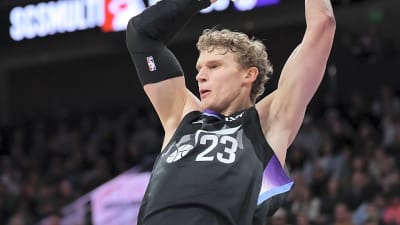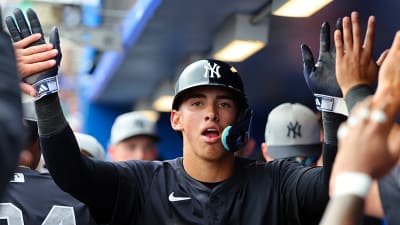
Like any up-and-coming team, the Detroit Pistons want to keep their momentum. To that point, they didn’t just win 44 games in 2024-25, clinching the first playoff berth of the Cade Cunningham era. They amassed more than three times as many victories as they did the previous season (14). In fact, that +30 win year-to-year jump was the sixth-largest turnaround in NBA history (h/t Detroit Free Press reporter Marlowe Alter).
Heading into 2025-26, the Pistons are going to look much different than last season though. So much so that they won’t even have the same starting five.
Predicting Pistons Starting Five For 2025-26 Season
Malik Beasley and Tim Hardaway Jr., wings with a penchant for raining in 3s, are out. Interestingly, although Beasley received the most praise, Hardaway started every game he played (77). Indeed, he started more than four times as many games as Beasley (18). So, with the 33-year-old signing a one-year deal with the Denver Nuggets, he’s obviously one starter who the Pistons have to replace.
With that in mind, though Jaden Ivey is constantly on the injury report, it’s important to remember that Hardaway wasn’t starting in place of him.
Jaden Ivey or Ausar Thompson?
The person who actually supplanted Ivey in the first unit was Ausar Thompson. This wasn’t because the 2023 No. 5 pick is a prototypical athlete who’s cut like an action figure. He’s also a truly elite, top-of-the-line defender. Thus, after starting 48 games in 2024-25, he could feasibly be demoted to the second unit. Yet, his point-of-attack defense is so awe-inspiring that the Pistons may not want to.
If Ivey displayed the same level of defensive upside, their decision would be easier. Yet, there’s a gulf between his defensive impact and Thompson’s. On top of that, because Ivey and Cunningham are both high usage ball-handlers with questions about their 3-ball, his fit next to the Pistons face of the franchise is iffy.
Indeed, when looking at their perimeter group, the only player whose starting spot is solidified is Cunningham.
Verdict: Jaden Ivey, For Now…
Though Ivey has to prove it wasn’t an anomaly, he did shoot 40.9 percent from 3 in 2024-25, making the backcourt pairing with Cunningham more feasible. Furthermore, though Cunningham is the team’s offensive engine, he shouldn’t have to do all the heavy lifting. That being said, the speedy Ivey has a career averages of 16.1 points and 4.4 assists per game. Ultimately, those aren’t All-Star numbers but he’s still particularly valuable offensively.
As a result, Ivey will likely enter the season with the first unit. Keep in mind that the 2022 No. 5 pick has started in 164 of the 181 games he’s played.
Ausar Thompson or Ron Holland?
As previously stated, Thompson is an exceptional defender. Partially due to his extraordinary physique, he’s also pretty effective as a cutter, lob threat and in the dunker’s spot. He also adds value with his burgeoning playmaking and scoring abilities. The glaring hole in his game is the one that’s been present this Day 1: his outside jumper.
In 122 games, Thompson is a career 19.8 percent 3-point shooter. He’s not much better on corner 3s, shooting 23.3 percent, the shorter distance not enough to mask his robotic mechanics and calloused touch. Last but not least, Thompson has made fewer than 25 percent of his catch-and-shoot threes.
Suffice it to say, he’s no Hardaway (Jr.). If the Pistons plan is to continue surrounding Cunningham with shooters, then he’s not their guy. At the same time, Thompson’s defense has become so valuable to Detroit, they’d likely be loathe to remove him from the starting lineup. Though not quite on his level as a deep threat, he’s similar to Minnesota Timberwolves defensive specialist Jaden McDaniels, a career 34.8 percent 3-point shooter.
Verdict: TBD
If Cunningham and Ivey are starting, the Pistons could prefer to have a defensive specialist that could help them conserve energy on offense. That fits Thompson’s description to a t. Of course, Thompson isn’t their only promising defender. 2024 No. 5 pick Ron Holland is too. On top of that, Holland has nascent passing abilities.
He’s a more aggressive and confident scorer, which are traits that people want to see from starters. Like Thompson, he can excel as a cutter, a lob threat or in the dunker’s spot. However, his 3-ball isn’t much better than Thompson’s, if any.
Frankly, this is a battle that may have to be hashed out in training camp. For starters, perhaps Thompson or Holland found their stroke during the summer. This and other factors could lead to one meshing better with the first unit than the other.
Tobias Harris or Duncan Robinson?
Tobias Harris‘s locker room leadership was invaluable for the Pistons in 2024-25. This and his career body of work will give him the leg up on his competition entering training camp. Nonetheless, there’s no way to be objective and ignore the fact that Harris played below expectations.
Though he started in all 73 games he played, he averaged 13.4 points per game on 34.5 percent shooting from 3. That’s simply not what was expected. Conversely, despite starting in just 37 of the 74 games he played last season, Duncan Robinson averaged 11.0 points per game and shot 39.3 percent from 3.
Verdict: Tobias Harris, For Now…
This will be one of Pistons head coach J.B. Bickerstaff’s most important decisions. As a stretch-four is one of the most valuable archetypes in the NBA, particularly for a team where reliable shooters are scarce and spacing is needed. Ultimately, Harris is a better all-around player than Robinson. Yet, Robinson is far more consistent in an area that’s a real need for Detroit.
Harris will probably get the starting nod, at least for the season opener. However, if his 2024-25 campaign is looking like a repeat and Robinson can continue playing respectable defense, he could usurp the 14-year NBA veteran.
Jalen Duren or Isaiah Stewart
Jalen Duren entered the NBA with more hype than Isaiah Stewart. Nonetheless, over the years, Stewart has shown that the gap between he and Duren’s defense isn’t that large. Duren is undoubtedly the more impressive athlete and is now listed at 6-foot-10, giving him a two-inch height advantage. Still, Stewart’s timing and tenacity allow him to be quite effective at that end.
The biggest (read: not only) difference between the two is the way that they operate on offense. Though not strictly a rim-runner, the bulk of Duren’s field goal attempts (59.5 percent) comes in the restricted area. Conversely, 57.1 percent of Stewart’s attempts are further than three feet away from the rim. More importantly, 26.6 percent of Stewart’s shots have come from 3-point range, which he’s converted at a 34.5 percent rate.
Due to his physical advantages, Duren is more equipped for the physical toll of being a full-time starting center. His elite rebounding, consistent shot-blocking and helpful playmaking deserve to be praised. Yet, given how many of the Pistons projected rotation players excel when attacking the rim but have problems converting from long-distance, Stewart’s ability to space the floor can’t be ignored.
Verdict: Jalen Duren, For Now…
There’s an old adage: ‘If ain’t broke, don’t fix it.’
This is exactly what comes to mind when deciding who would be better to start. To that point, the Pistons were just fine starting Duren all last season.
At the same time, there are clearly merits to Stewart being promoted to the first unit. If Duren, Cunningham, Ivey or even the team as a whole goes through a rough stretch, Bickerstaff could decide flipping Stewart and Duren’s roles is the change that they need.
More must-reads:
- Four second-year players to watch for in 2025-26 NBA season
- Report: Teams reluctant to discuss key offseason move with Bulls
- The 'NBA minutes leaders by season' quiz
Breaking News
Trending News
Customize Your Newsletter
 +
+
Get the latest news and rumors, customized to your favorite sports and teams. Emailed daily. Always free!








